Did you know … there’s a simple add-on service that’s easy to implement, proven to increase average order value, and makes your customers’ lives easier during the holiday rush?
Big retailers have been offering this service for years.
And yet, when over 50 online brands — each generating more than $10 million in annual sales — were surveyed about their holiday ecommerce marketing plan …
This add-on service was the number one “will not use” onsite offer.
Alright, enough pretend drama. The add-on on service in questions is, of course, gift-wrapping.
Hallmark estimates that the gift wrapping industry in the U.S. alone generates $3.2 billion in retail sales. This number includes things like wrapping paper, wrapping tissues, ribbons, gift bags, gift boxes, etc.
While it’s true that most people plan to wrap their own presents, wrapping comes with added complications:
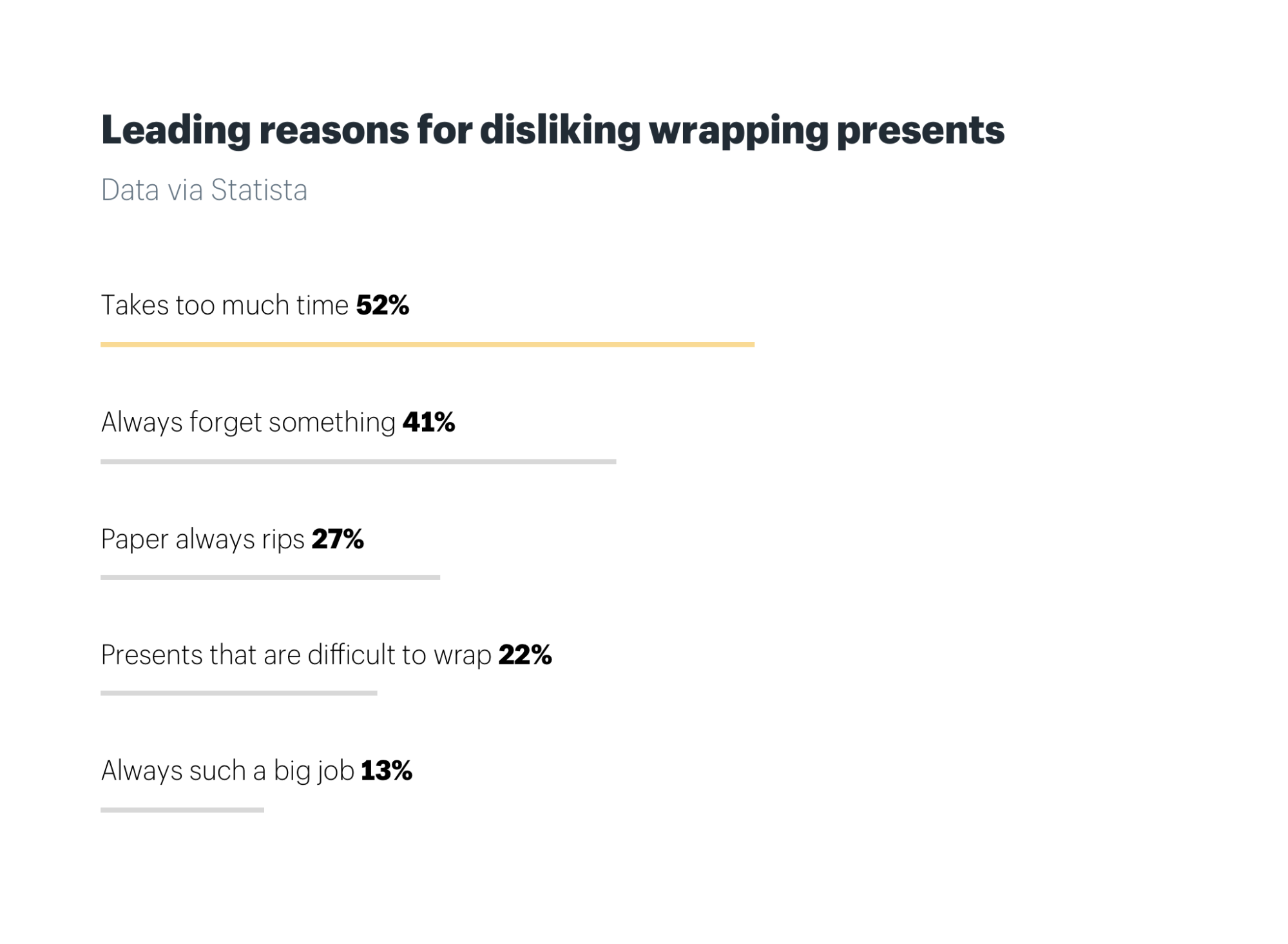
These reasons are where offering online shoppers the opportunity to get their gifts wrapped before shipping comes into play. It’ll save your customers the hassle of doing it themselves while at the same time position your brand as customer service leaders.
So, how do you do it?
Ecommerce Gift Wrapping Options
As a baseline, Amazon offers gift wrapping on select FBA products for $3.49 to $5.99 (depending on size):
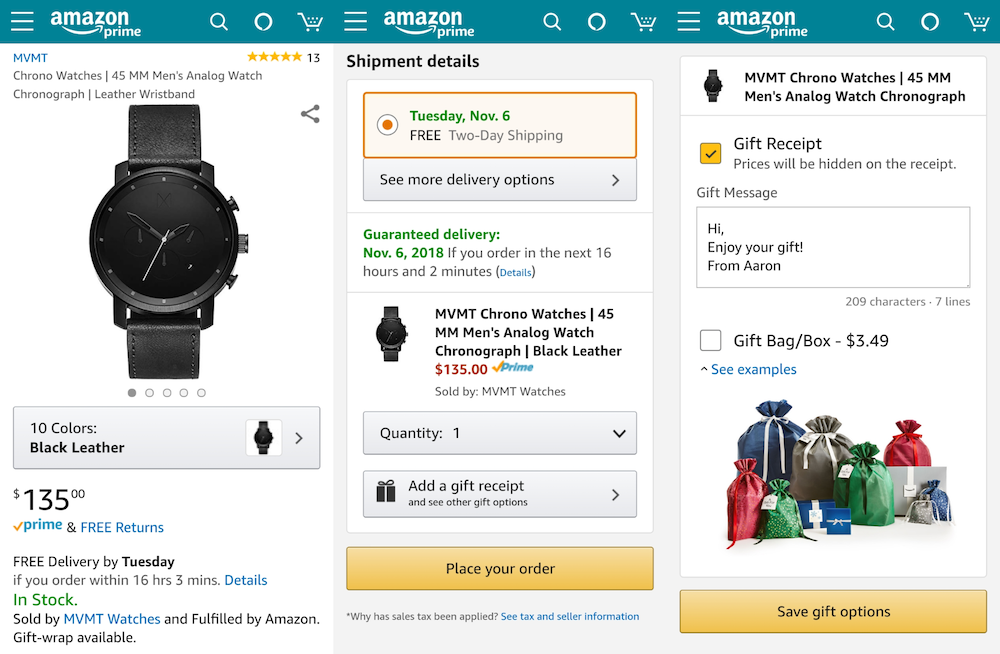
As with most things Amazon, the price and process are optimized for speed and simplicity (i.e., margins). As a result, FBA gift wrapping has been met with mixed reviews.
If your business decides to offer gift wrapping, the result has to be nothing less than sheer delight.
Why? Because by stepping into the gift-wrapping game, you’re stepping into a sacred place between friends and family. Your customers are trusting you with the responsibility of delivering the moment before the moment. Don’t let them down.
Tactically, what are your options?
Gift Wrapping as a Product within the Cart
On Shopify and Shopify you can add a gift-wrap option directly to your checkout — similar to Amazon — via light coding with the help of this guide. In this scenario, gift wrapping is run as a product and can be set up either as a flat rate or as a per-product charge:
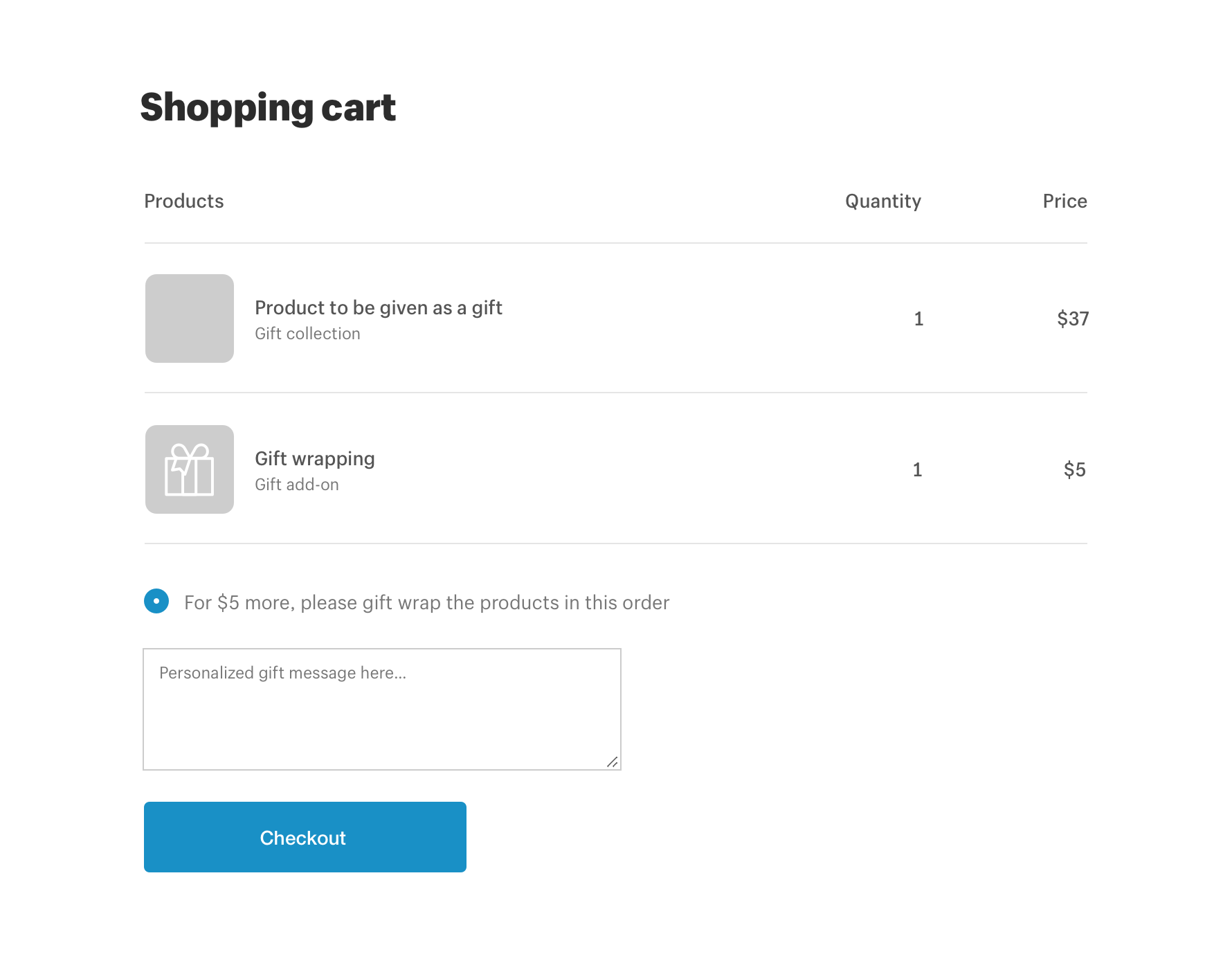
That’s what John’s Crazy Socks does, and it’s the perfect gift-wrapping extension of the company’s mission to “spread happiness through socks.”
From the beginning, John (on the left below) added his personal touch by shipping each order in a red box, sprinkling in some Hershey’s Kisses, and including a handwritten appreciation in each order.

“Jeff Bezos is not putting candy and a thank you note in every package,” John says with a smile.
This holiday season, here’s what that looks like …
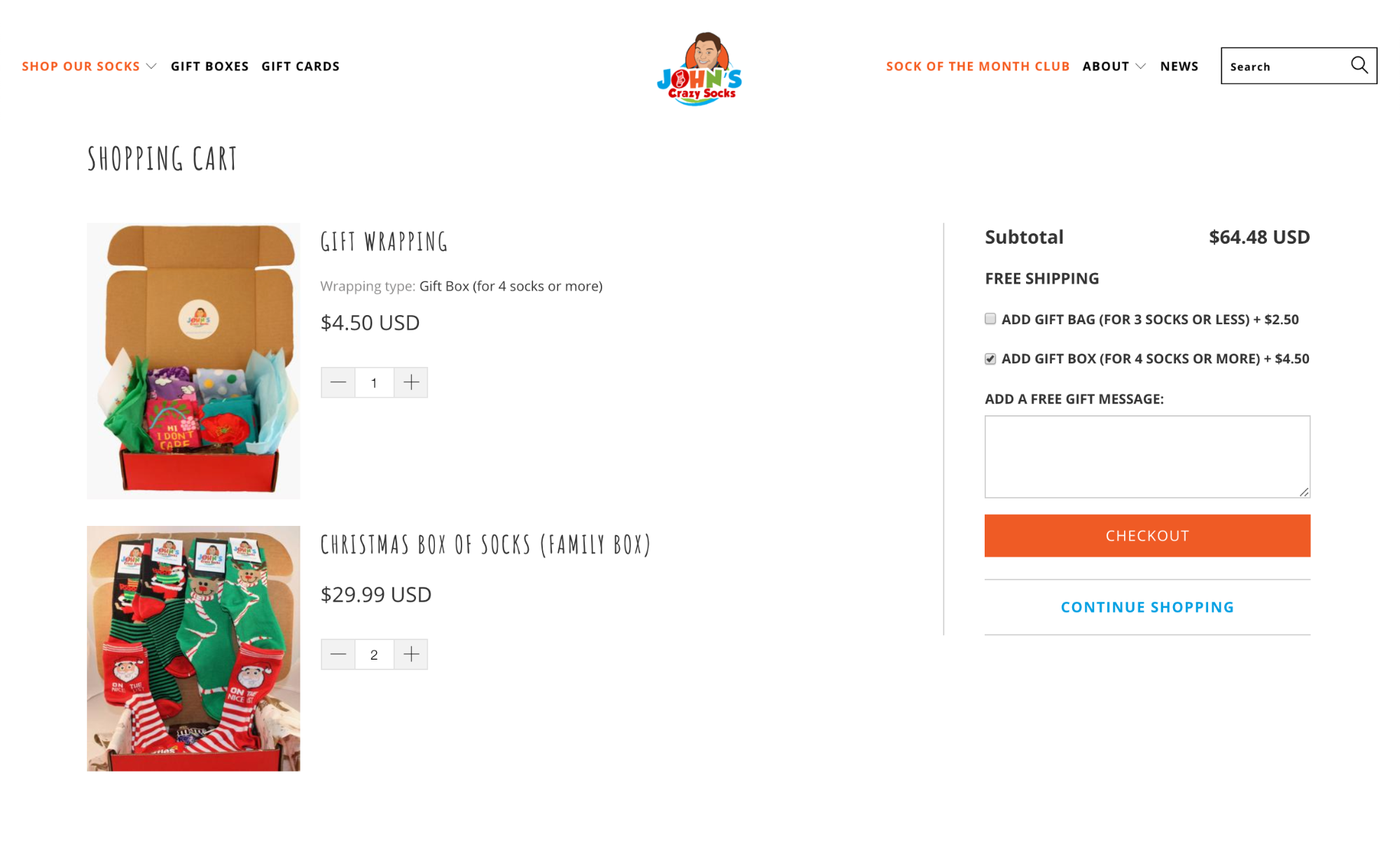

John’s Crazy Socks’ commitment to customer happiness has led to …
- Annual revenue of over $4 million
- 118,000 orders to all 50 states and 44 countries
- Year-over-year boosts in conversion rate (15%), total sales (251%), and returning customer rate (2,067%)
Gift Wrapping as a Seasonal Pop-Up
For an even more interactive experience, Bold Commerce — a Shopify Partner — has three options, each of which are built around leveraging gift wrapping as a way to increase AOV through spending thresholds:
- Header bar that automatically updates based on cart value
- Cart “add-on” similar to the above examples
- Pop-ups that appear after add to cart
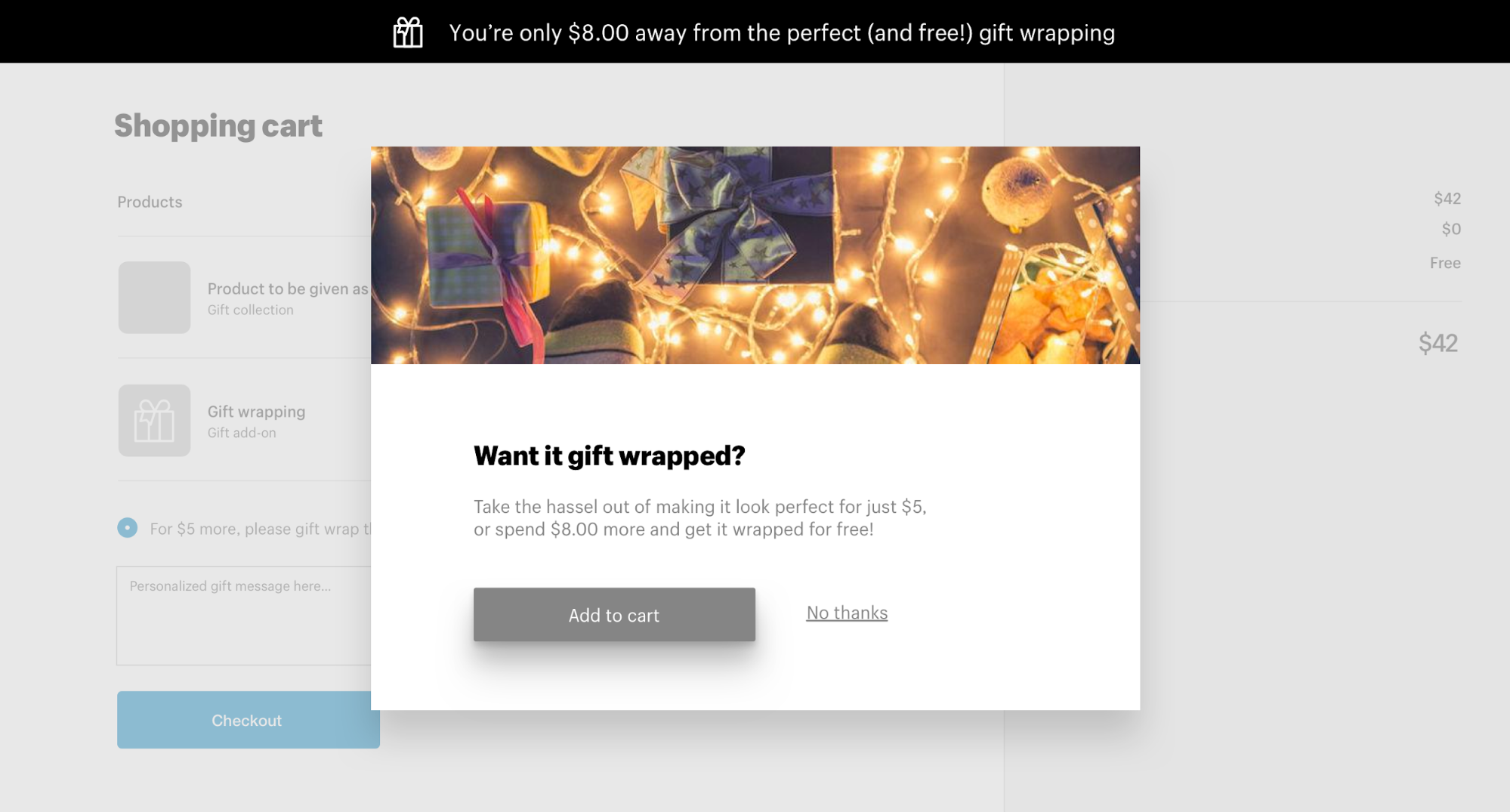
In addition to Bold Commerce, there are other apps — like Gift Wrap Plus and Gift Checkout to name just two.
Other Gift-Wrapping Considerations
▢ When should you offer gift wrapping?
Only during the holiday season when customers are more likely to order it or throughout the year for birthdays and other holidays?
▢ Offer gift-wrapping for everything or only on selected items?
Different merchandise can take wildly different times to wrap. Something like a book is quick and easy while a soft Teddy bear will take more time.
▢ How should gifts be sent and fulfilled?
When a customer orders gift-wrapping, the wrapped gift can either be sent to the customer to hand over the gift themselves or sent straight to the gift receiver.
In the latter case, you shouldn’t include any additional prices on the invoice but, instead, use a gift recipe with clear return instructions (if applicable). Are you set-up in a way that enables that?
▢ How should you send gift messages?
John’s Crazy Socks — given their deep commitment to customer happiness — hand writes their notes:
Alternatively, there are a host of other options for hand-written notes on Shopify via outsourcing:
▢ How much to charge for the service?
Should it be $3, $4, $6? Only offer it for free when you order $X worth of stuff? Make it free for only your highest-spending customers or for the ones that spend the least to incentivize them to spend more? Charge everyone the same? No right or wrong answers here.
▢ Should you wrap it yourself?
Norstrom, for example, has gone one step further and offers a “Gift Kit” for $2 that includes a gift box, tissue paper, a ribbon, and a tag. This is brilliant as the only cost to them is the cost of materials. No need to wrap anything, simply add the kit to the order.

To Wrap or Not to Wrap?
Gift wrapping — no matter how simple or elaborate — is a tangible and delight-inducing customer service. And, once a customer becomes loyal to you based on service, it will be difficult for competitors to lure them away.
It can also be a great marketing tool, an opportunity for add-on sales, and an excellent way to build rapport with loyal customers. Not to mention, it can offer customers a convenience that is just plain pretty.
Read more
- Customer Retention: How to Turn New Shoppers into Repeat Customers
- How to Strengthen Your Marketing Using Emotional Intelligence
- Why Leading Indicators in Ecommerce Are the Key to Success & How to Find Them
- How to Monetize Dormant Customers With a Successful Winback Campaign
- How To Maintain A Personal Touch With Customers As You Grow
- Best Practices for Reopening your Retail Store after COVID-19
- How to Personalize for Unknown Black Friday Cyber Monday Mobile Visitors
- How to Reduce Fears and Bring Clarity to the Checkout
- Ecommerce Customer Experience: Mastering Acquisition and Retention
- Guest Checkouts: Definition, Benefits, and Best Practices


